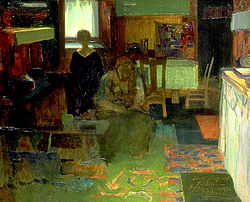| Title | Image | Year | Collection | Comments and SIRIS ID [nb 1] |
|---|
Aglaia
(or The Graces: Aglaia),
mural |  | 1896 | Library of Congress,
Washington, DC | Subject: Aglaia, patroness of Husbandry, seated in landscape, holding shepherd's crook. SIRIS Control Number 08480647. [2] |
Euphrosyne
(or The Graces: Euphrosyne),
mural |  | 1896 | Library of Congress,
Washington, DC | Subject: Euphrosyne, patroness of Beauty, seated in landscape, looking at herself in hand mirror. SIRIS Control Number 08480649 [2] |
Thalia (or The Graces: Thalia),
mural |  | 1896 08480648 | Library of Congress,
Washington, DC | Subject: Thalia, patroness of Music, seated in landscape, holding lyre. |
The Four Seasons,
mural | 

 | 1896 | Library of Congress,
Washington, DC | |
Sketch for a Mural,
oil on canvas |  | c. 1890 | | Dimensions: 32.9 in x 40.1 in (83.6 cm x 101.9 cm). SIRIS Control Number 62641460 [2] |







